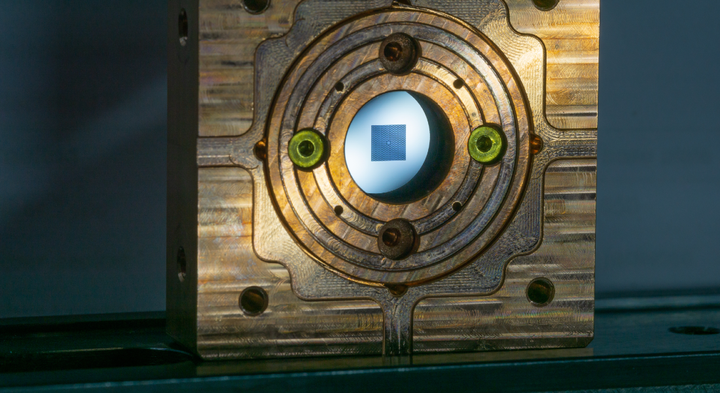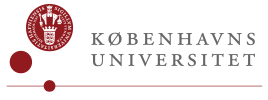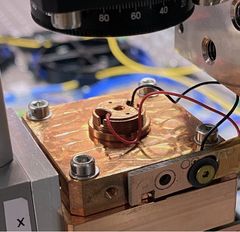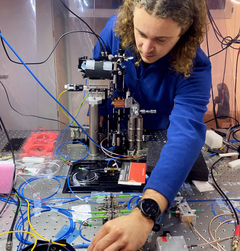Internet can achieve quantum speed with light saved as sound
Researchers at the University of Copenhagen’s Niels Bohr Institute have developed a new way to create quantum memory: A small drum can store data sent with light in its sonic vibrations, and then forward the data with new light sources when needed again. The results demonstrate that mechanical memory for quantum data could be the strategy that paves the way for an ultra-secure internet with incredible speeds.

Just beneath Niels Bohr's old office is a basement where scattered tables are covered with small mirrors, lasers and an agglomeration of all types of devices connected by webs of wires and heaps of tape. It looks like a child’s project gone too far, one that their parents have tried in vain to get them to clean up.
While it is difficult for the untrained eye to discern that these tables are actually the home to an array of world-leading research projects, the important stuff is happening within worlds so small that not even Newton's laws apply. This is where Niels Bohr's quantum physical heirs are developing the most cutting-edge of quantum technologies.
One of these projects stands out – for physicists at least – by the fact that a gizmo visible to the naked eye is able to achieve quantum states. The quantum drum is a small membrane made of a ceramic, glass-like material with holes scattered in a neat pattern along its edges.
When the drum is beaten with the light of a laser, it begins vibrating, and does so, so quickly and undisturbed, that quantum mechanics come into play. This property has long since caused a stir by opening up a number of quantum technological possibilities.
Now, a collaboration across various quantum areas at the Institute has demonstrated that the drum can also play a key role for the future’s network of quantum computers. Like modern alchemists, researchers have created a new form of "quantum memory" by converting light signals into sonic vibrations.
In a just-published research article, the researchers have proven that quantum data from a quantum computer emitted as light signals – e.g., through the type of fiber-optic cable already used for high-speed internet connections – can be stored as vibrations in the drum and then forwarded.
Previous experiments demonstrated to researchers that the membrane can remain in an otherwise fragile quantum state. And on this basis, they believe that the drum should be able to receive and transmit quantum data without it "decohering", i.e., losing its quantum state when the quantum computers are ready.
"This opens up great perspectives for the day when quantum computers can really do what we expect them to. Quantum memory is likely to be fundamental for sending quantum information over distances. So, what we’ve developed is a crucial piece in the very foundation for an internet of the future with quantum speed and quantum security," says postdoc Mads Bjerregaard Kristensen of the Niels Bohr Institute, lead author of the new research article.
Ultra-fast, ultra-secure
When transferring information between two quantum computers over a distance – or among many in a quantum internet – the signal will quickly be drowned out by noise. The amount of noise in a fiber-optic cable increases exponentially the longer the cable is. Eventually, data can no longer be decoded.
The classical Internet and other major computer networks solve this noise problem by amplifying signals in small stations along transmission routes. But for quantum computers to apply an analogous method, they must first translate the data into ordinary binary number systems, such as those used by an ordinary computer.
This won’t do. Doing so would slow the network and make it vulnerable to cyber-attacks, as the odds of classical data protection being effective in a quantum computer future are very bad.
"Instead, we hope that the quantum drum will be able to assume this task. It has shown great promise as it is incredibly well-suited for receiving and resending signals from a quantum computer. So, the goal is to extend the connection between quantum computers through stations where quantum drums receive and retransmit signals, and in so doing, avoid noise while keeping data in a quantum state," says Mads Bjerregaard Kristensen. He adds:
"In doing so, the speeds and advantages of quantum computers, e.g., in relation to certain complex calculations, will extend across networks and the Internet, as they will be achieved by exploiting properties like superposition and entanglement that are unique to quantum states," he says.
If successful, the stations will also be able to extend quantum-secured connections, whose quantum codes could also be lengthened by the drum. These secure signals could be sent over various distances, whether around a quantum network or across the Atlantic, in the quantum internet of the future.
Flexible, practical - possibly groundbreaking as Quantum RAM
Research is being conducted elsewhere to an alternative where a data-carrying light source is directed at an atomic system and temporarily shifts the electrons in the atom, but the method has its limitations.
"There are limits to what you can do with an atomic system, as we can't design atoms or the frequency of the light that they can interact with ourselves. Our relatively "large" mechanical system provides more flexibility. We can tinker and adjust, so that if new discoveries change the rules of the game, there is a good chance that the quantum drum can be adapted," explains Professor Albert Schliesser, co-author of the research article.
"For better or worse, our abilities as researchers are mostly what define the limits for how well it all works," he points out.
The drum is the latest and most serious take on mechanical quantum memory as it combines a number of properties: The drum has low signal loss – i.e., the data signal’s strength is well retained. It also has the tremendous advantage of being able to handle all light frequencies, including the frequency used in the fiber optic light cables upon which the modern Internet is built.
The quantum drum is also convenient because data can be stored and read whenever needed. And the record-long 23 milliseconds of memory time already achieved by researchers makes it far more likely that the technology may one day become a building block for systems of quantum networks as well as the hardware in quantum computers.
"We are out early with this research. Quantum computing and communication are still at an early stage of development, but with the memory we’ve obtained, one can speculate that the quantum drum will one day be used as a kind of quantum RAM, a kind of temporary “working memory” for quantum information. And that would be groundbreaking," says the professor.
*
Facts: How it works
Prior to the data-carrying light signal hitting the quantum drum membrane, an "auxiliary laser" ensures that the membrane's natural vibrations, which come from ambient conditions, are brought under control. This stabilizes the diaphragm with a drum beat that is at the exact frequency it likes best. This is called resonance.
The drum becomes very sensitive when it resonates with the auxiliary laser, which, among other things, allows it to detect the signal stored in the data-carrying light with quantum precision.
Once data-filled light hits, its signal becomes part of the drum's vibrations. Here, they can be stably preserved in a kind of sound memory prior to being sent onwards in a third laser, which is shot at the drum and mirrored out in a cable with data from the original light signal encoded.
Facts: Computers and quantum data
A classical computer works like a large network of switches that can be in either on or off positions. These systems are called binary because of the two states that form the basis of the calculations performed by the computer. Like beads on an abacus, the on and off switches form patterns of binary code.
A quantum computer performs calculations with the help of quantum mechanics, and exploits that its "quantum switches", or qubits, can be in quantum states, including superposition, where they are simultaneously on and off. This allows a quantum computer to rapidly manage large amounts of information in a way that classical computers cannot.
Quantum data transmitted via light signals can maintain its quantum state as long as it is sufficiently undisturbed. And, the Niels Bohr Institute's quantum drum can both receive and forward signals without disturbance.
Facts: Quantum-secured connections
The method involves sending qubits of quantum data in an ultra-short light signal: A couple of entangled photons can be used to create nearly unbreakable codes.
These types of connections also ensure that any attempt to hack access will be exposed, as quantum law says that whenever something is observed, it changes.
Facts: Superposition and entanglement
Nature's rulebook is different in the quantum mechanical world. In particular, two quantum states neutralize the limitations of the ordinary world, giving quantum computers incredible powers.
Superposition: In quantum mechanics, superposition allows a particle to be in multiple states at the same time until it is measured. For example, a quantum bit (qubit) can be both 0 and 1 at the same time until it is measured and collapses to a certain state. Qubits leverage superposition to perform multiple calculations at once.
Tangling: Einstein referred to it as "spooky action at a distance". The states of two or more entangled particles are closely related. A change in the state of a particle will instantly affect the state of the particles it is entangled with, regardless of distance. It is this property that makes it possible to create secure connections using codes that cannot be decoded without a tangled particle as a key. The condition also opens up the possibility of developing quantum teleportation, where information can be transferred without any direct transfer of particles.
Behind the research:
The following researchers from the Niels Bohr Institute have contributed to the study:
Mads Bjerregaard Kristensen
Eric C. Langman
Albert Schliesser
and Nenad Kralj, (currently affiliated with the Faculty of Physics, University of Rijeka, Croatia)
Keywords
Contacts
Mads Bjerregaard KristensenPostdocNiels Bohr Institute, University of Copenhagen
Tel:+45 35 33 30 20mads.kristensen@nbi.ku.dkAlbert SchliesserProfessorNiels Bohr Institute, University of Copenhagen
Tel:+45 35 32 54 01albert.schliesser@nbi.dkKristian Bjørn-HansenJournalist and Press ContactFaculty of Science, Copenhagen University
Tel:+45 93516002kbh@science.ku.dkImages
Links
ABOUT THE FACULTY OF SCIENCE
The Faculty of Science at the University of Copenhagen – or SCIENCE – is Denmark's largest science research and education institution.
The Faculty's most important task is to contribute to solving the major challenges facing the rapidly changing world with increased pressure on, among other things, natural resources and significant climate change, both nationally and globally.
Subscribe to releases from Københavns Universitet - Det Natur- og Biovidenskabelige Fakultet
Subscribe to all the latest releases from Københavns Universitet - Det Natur- og Biovidenskabelige Fakultet by registering your e-mail address below. You can unsubscribe at any time.
Latest releases from Københavns Universitet - Det Natur- og Biovidenskabelige Fakultet
Ny institutleder på IFRO: ”Faglighed og fællesskab går hånd i hånd”1.7.2025 10:49:17 CEST | Pressemeddelelse
Per Svejstrup er fra 1. august ansat som institutleder på Institut for Fødevare- og Ressourceøkonomi (IFRO). Den kommende leder træder ind i rollen med stor respekt for IFRO's faglige og kollegiale kultur med klare ambitioner for fremtiden.
Dangerous Variant of Salmonella Still Not Eradicated – Researchers Point to the Solutions1.7.2025 09:53:23 CEST | Press release
The infectious and multi-resistant cattle disease Salmonella Dublin can be fatal to both humans and animals and causes significant losses for farmers. Although Denmark has attempted to eradicate the disease since 2008, it has not yet succeeded. A study from the University of Copenhagen points to possible reasons – and the necessary solutions.
Farlig type salmonella er stadig ikke nedkæmpet i Danmark – forskere peger på løsningerne30.6.2025 09:54:03 CEST | Pressemeddelelse
Den smitsomme og multiresistente kvægsygdom Salmonella Dublin kan være dødelig for både mennesker og dyr og medfører desuden betydelige tab for landmændene. Selvom Danmark har forsøgt at udrydde sygdommen siden 2008, er det ikke lykkedes. Et studie fra Københavns Universitet peger på den mulige årsag og de nødvendige løsninger.
Her er de blomster som bier og mennesker bedst kan lide27.6.2025 07:12:14 CEST | Pressemeddelelse
Botanikere fra Københavns Universitet og Storbritannien satte sig for at finde de bedste blomsterblandinger til bier og svirrefluer. Resultaterne gør det lettere for bl.a. haveejere og kommuner at plante de perfekte spisekamre for insekterne, som samtidig fryder det menneskelige øje.
Nyt dansk forskningscenter skal skabe designede proteiner med kæmpe potentiale25.6.2025 08:00:00 CEST | Pressemeddelelse
Designede proteiner forventes at få en banebrydende effekt på en lang række områder, fra behandling af sygdomme til håndtering af miljøproblemer. Med en bevilling på 700 mio. kr. fra Novo Nordisk Fonden og under ledelse af professor Dek Woolfson har det nye Center for Protein Design (CPD) på Københavns Universitet ambitioner, der matcher potentialet. CPD vil sætte sig i spidsen for udviklingen af proteindesign og områdets anvendelsesmuligheder gennem tværfagligt samarbejde på Københavns Universitet og partnerskaber i Danmark og udlandet.
In our pressroom you can read all our latest releases, find our press contacts, images, documents and other relevant information about us.
Visit our pressroom

